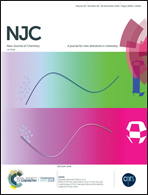Impact of the donor substituent on the optoelectrochemical properties of 6H-indolo[2,3-b]quinoxaline amine derivatives†
Abstract
A series of donor–acceptor-based 6H-indolo[2,3-b]quinoxaline amine derivatives were synthesized with different donor amines. The impact of the different donor moieties on 6H-indolo[2,3-b]quinoxaline was systematically examined by absorption-emission spectroscopy, cyclic voltammetry and theoretical studies. The photophysical properties of these molecules, such as intramolecular charge transfer transitions (400 to 462 nm) and emission (491 to 600 nm), were influenced by the nature of the peripheral amines. Further, the solid-state emission demonstrated by some of the dyes aroused our interest in performing photophysical studies on the aggregation-induced emission phenomenon; these dyes showed nanoparticle formation in THF/H2O solvent mixtures. Varying the strength of the peripheral amines in the derivatives also tuned the electrochemical data, with lower band gaps (1.56 to 2.21 eV) and comparable HOMO–LUMO energy levels with reported ambipolar materials. The donor–acceptor architectures and HOMO–LUMO energies were further rationalized using DFT/TDDFT calculations. Thus, the opto-electrochemical studies and high thermal stability of these molecules indicate their potential application as solid-state emissive, ambipolar materials in optoelectronic devices.
![Graphical abstract: Impact of the donor substituent on the optoelectrochemical properties of 6H-indolo[2,3-b]quinoxaline amine derivatives](/en/Image/Get?imageInfo.ImageType=GA&imageInfo.ImageIdentifier.ManuscriptID=C9NJ05558D&imageInfo.ImageIdentifier.Year=2019)


 Please wait while we load your content...
Please wait while we load your content...